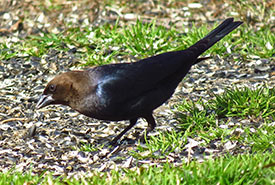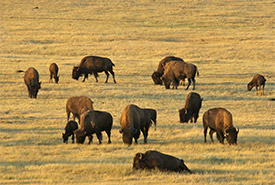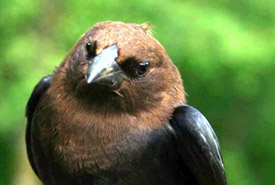Unlikely animal pairings: Part two

Brown-headed cowbird (Photo by David Dodd CC BY-NC)
This is part two of a two-part series on unlikely animal pairings. Check out part one, the hunting partnership between an American badger and a coyote, here.
Another unlikely animal partnership features a bird that is known to take advantage of others animals, without giving much back: the brown-headed cowbird. It has two distinct partnerships with other species during its lifespan, but isn’t known for helping out in return.
The brown-headed cowbird’s name describes the bird fairly well, as the bird has muddy-brown plumage on its head. One of the most common places to see this bird is on a cow’s back.

Plains bison, Old Man on His Back Prairie and Heritage Conservation Area, SK (Photo by NCC)
Just like its name suggests, the brown-headed cowbird has a partnership with cattle or, more historically, with bison. When bison herds numbered as much as 70 million in the early 1800s, they literally supported entire ecosystems on their back. Billions of insects survived off bison, either by biting them or using their excrement as a source of nutrients. Many birds, including the brown-headed cowbird, ate insects off the bison's backs to obtain nutrients. Cowbirds also feasted on insects that the bison's hooves stirred up from the ground. These hordes of insects and birds followed bison herds, resulting in travelling ecosystems slowly crossing the prairie.
Related blog posts
Scientists often cite the relationship between brown-headed cowbirds and bison as a prime example of commensalism. Commensalism is a type of relationship between two species, where one species benefits and the other is neither benefited nor harmed. Bison were not bothered by brown-headed cowbirds landing on them and eating the insects off of them, but they weren’t particularly helped by the situation either.
When brown-headed cowbirds aren’t following cattle, they might be engaging in their second form of partnership behaviour. Cowbirds are parasitic nesters, meaning that they don’t build their own nests or raise their own young. Instead, they discretely lay their eggs in the nests of other bird species while the other bird isn’t there. Some species will spot the egg and remove it or build another nest, but most grassland songbird species will raise the parasitic egg as if it were their own.

Brown-headed cowbird (Photo by Stephen Davis)
The last century has had its ups and downs for cowbirds. The destruction of the great bison herds left the cowbirds to adapt to different conditions. With so few bison left, many cowbirds began to follow domestic cows and other livestock. They were also able to expand their habitat in the 20th century due to deforestation in eastern North America.
The brown-headed cowbird isn’t afraid to use other species to get ahead. It is adapted to a nomadic prairie lifestyle, following cattle so it can eat, and laying its eggs in other prairie birds’ nests. This bird is a great example of a species that relies on other species to survive.


